What goes where, and why? Starting to compose your painting.
Composition is key to the success of your painting. It helps you to invite the viewer into the scene and to look around the whole picture plane. Today I want to start introducing you to basic composition and how you can use it.
Angela Birchall
7/18/20256 min read
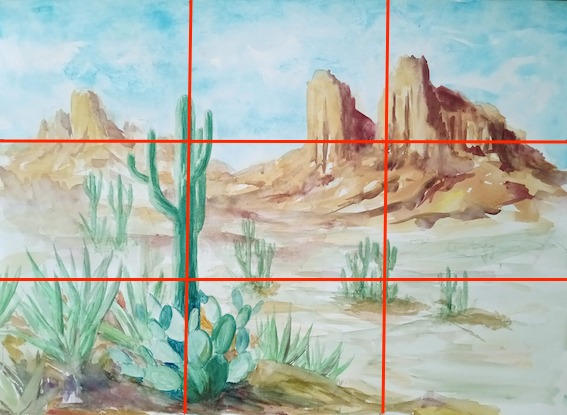

How do you decide what to put in a painting and where to put the different elements?
That question – or ones like it – is probably the single most asked question that I get either as an artist or an art teacher.
Composition is key to the success of your painting. It helps you to invite the viewer into the scene and to look around the whole picture plane, not to just land on one element and ignore the rest.
In the first of the ‘how to paint’ books that I am starting to compile I will obviously be talking about the composition used in the different painting exercises that I take you through. Until then, let me simplify what can be a complex subject and give you a straightforward guide to using composition either in creating your own paintings, ‘reading’ those of other artists, or even in taking better photographs.
I find it fascinating to look into how artists over the centuries have used the rules of composition that have been prevalent in their particular age and time. In the days of the old masters, composition was a highly structured mathematical formula of the Golden Ratio or Golden Rectangle – and of course every fan of the Da Vinci Code knows about the Fibonacci Sequence!
In future blogs I’ll show you how so many of the Dutch masters used the low-lying distant horizon to such dramatic effect in creating incredible skyscapes. Turner used the same format for works like “The Fighting Temeraire”. Or how two of the French Impressionists that I love, Monet and Pissarro, played with roads and paths to invite the viewer in, or keep them standing at the front with no entry point, to take the viewer on a slow meander or race them headlong into the scene. There’s even the classic paintings where Monet uses light and shade to break the rules and slow down what should be one of those headlong dashes.
All that and lots more are for another day. Today I want to start introducing you to basic composition and how you can use it.
Composition of thirds
These days, thank goodness, we mainly use the composition of thirds: 2 horizontal lines each a third of the way across the page or canvas from top and bottom, and 2 vertical lines each a third of the way in from left and right edge. In fact, many cameras will give you the 4 lines dividing the image in the viewfinder into 9 equal segments.
Whether you are painting from photographs, out on location, or even from your imagination, one aspect that you will need to consider is ‘composition’. That is, of course, not just the choice and placement of objects, but also the use of colours, light and shade so that you lead the viewer’s eye all round the painting.
When you think of dividing your picture into 9 segments, the one thing that you don’t want to do is to put whatever the main focal point of the picture is right in the middle of the picture – even portraits of a single head and shoulders will have the face slightly to the left or right and usually above or below the centre line. If you have your main focal point in the middle of the scene then your eye can go straight to that and ignore whatever is in the surrounding 8 segments.
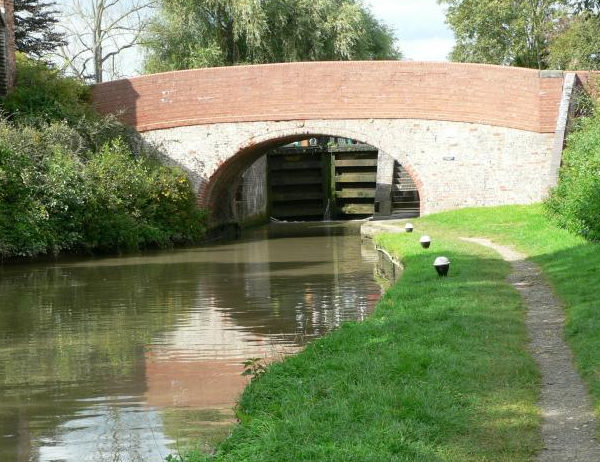

Just look at this picture (above) of a bridge. The dark arch of the bridge and the canal gate behind it are right in the centre and they catch the attention and keep it there.
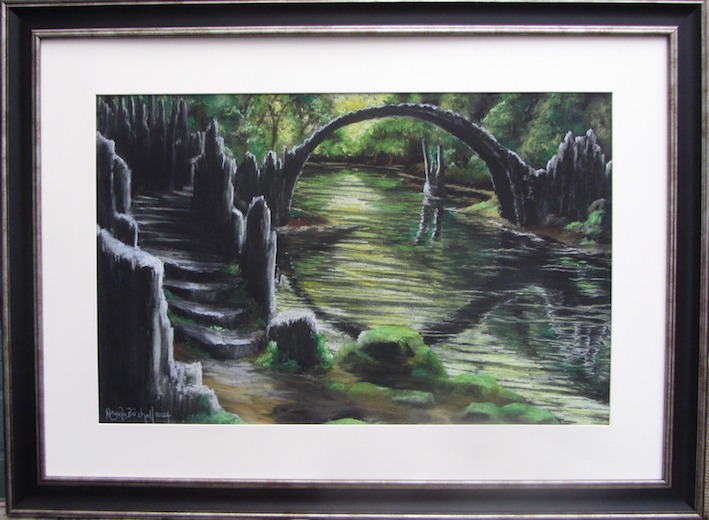

In the second one the subject is the Devil’s Bridge in Saxony, Germany. It is always photographed head on because the arch forms a perfect circle, so the challenge was to keep the idea of the perfect circle but also to put it onto the third lines.
Now let’s overlay the third lines onto the drawing (it’s drawn in soft pastels rather than painted) and you can see the compositional structure that I used.
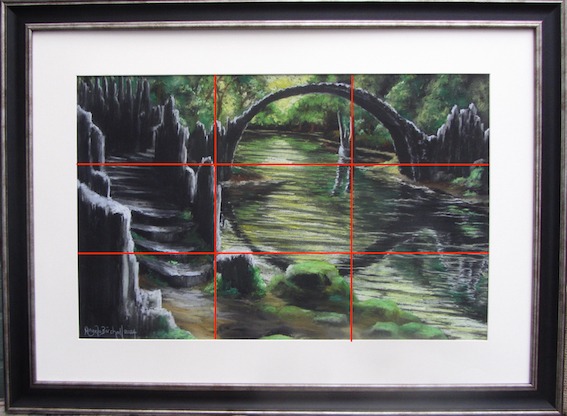

Although the main image is the full circle of bridge and reflection, and they do cover the central segment, they also go into 5 other segments. More importantly, the viewer is led into the picture with the path at the bottom of the picture plane and the use of light and dark taking you up the path, onto the steps, climbing up and up until the steps wind round the corner and onto the bridge. That’s where the title of the picture comes into play: “Dare you cross the Devil’s Bridge?”
The myth around the bridge is that it’s too fragile to be stable so it must be held up by magic powers, hence the name, the Devil’s Bridge – and before anyone tells me, yes, I know that there are Devil’s Bridges all over the world including 5 more in Germany, 14 in Italy, and no fewer than 49 in France!
Whether or not you dare to cross the bridge, your eye will take you up and over to the other side, up the silver-topped rock edges before swooping downwards to the reflection and back to dry land on the path from which you started. At that point, you will have gone round the entire painting and taken in all 9 segments of the picture even if you think that you have just looked at a picture of a bridge.
Dividing your landscape into thirds
In most landscapes, when you look at the horizontal thirds, the bottom third is the foreground, the middle third is the mid-ground and the top third is the sky and distant horizon. “Dare you cross the Devil’s Bridge?” uses this structure but you don’t get the sky and distant mountains in that as much as in landscapes like the ones below used in my watercolour classes to teach how to create distance in your landscapes.

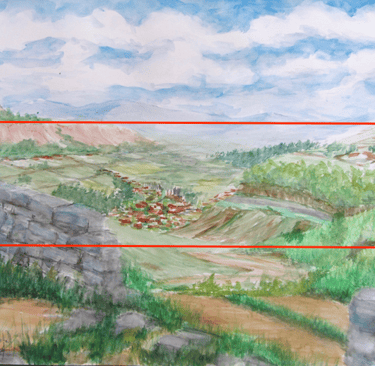
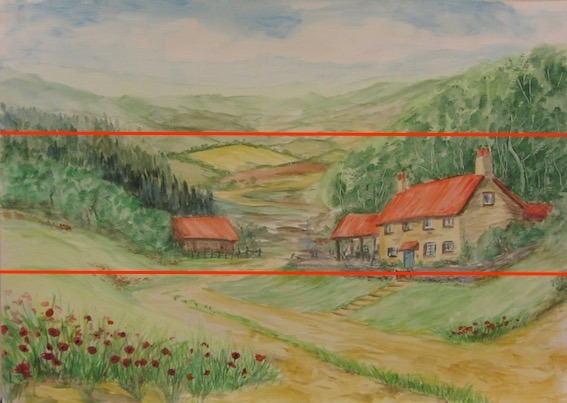

Just as we use horizon or foreground lines on the horizontal thirds, we also look for some strong vertical lines in the composition which we also try to place on or close to the vertical third lines.
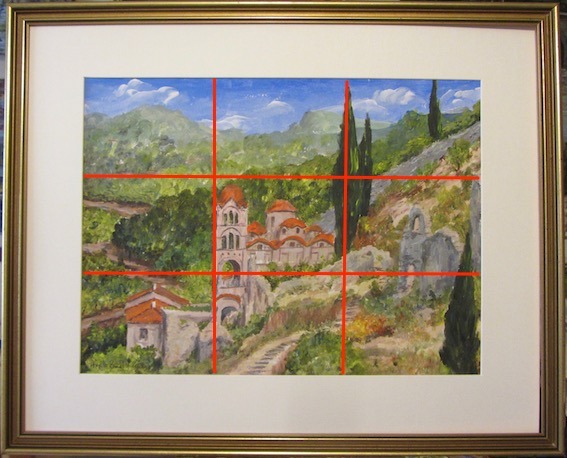

For landscapes, foreground trees as well as man-made structures fulfil this criterion easily, such as in this Greek hillside, where both the trees and the architecture give strong verticals . . .
but it could just as easily be rocks, cliff edges or mountains, like this desert scene where the strong foreground vertical is the tall cacti placed right on the third line.


They do say that rules are meant to be broken and that’s the case with this painting of canoeists paddling round a rock formation called “the fairy grotto”. It still has strong verticals but the horizontal thirds are switched. This time the distant horizon is on the lower third while the foreground line runs along the top third.
Next time I will focus on the other major element used to lead the viewer around the picture: the S shape. Meanwhile, try using the thirds when you are either planning your next drawing or painting or even taking photographs.
Rules are made to be broken
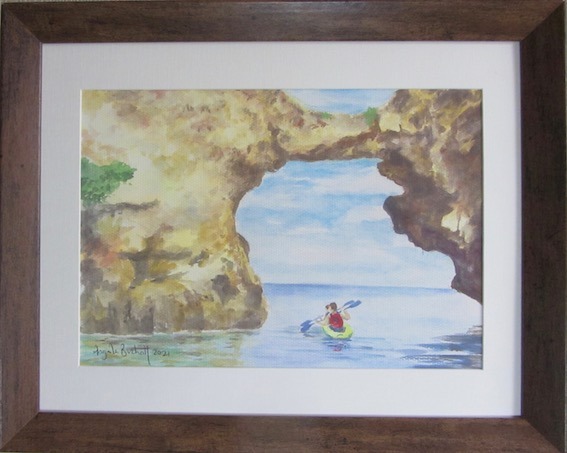

Get in touch
Use the message box to drop me a line if you want to:
purchase my paintings or drawings;
discuss commissioning me to create a unique work of art especially for you;
have a question to be answered in a future Picture Perfect blog post;
join one of my face-to-face painting or drawing classes in West Lancashire or have private coaching online;
discuss a bespoke staff development event using art to encourage teamwork and leadership
Contacts
0044 77242 00779
youcandrawandpaint@gmail.com

